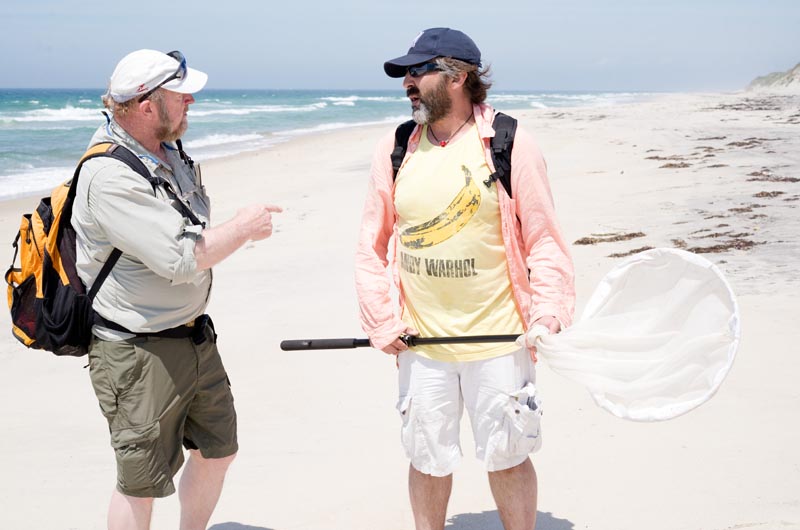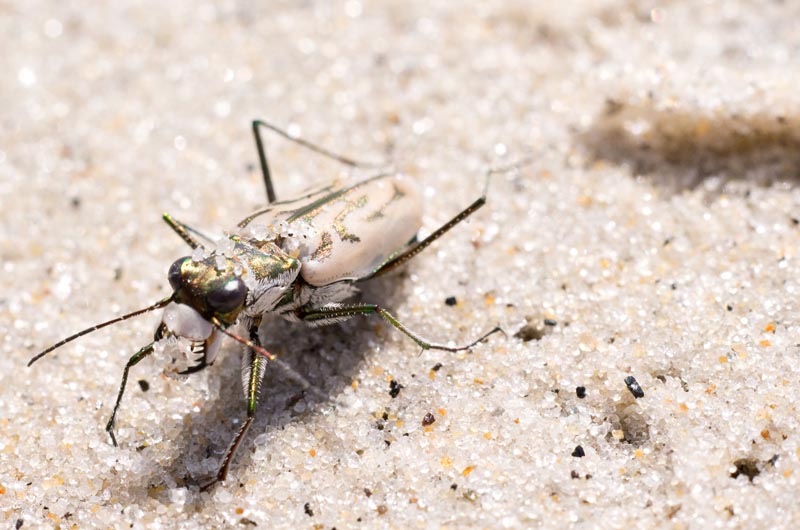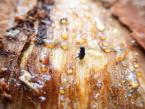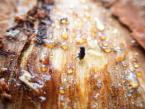The small, light-colored beetles flitting across the sand on a stretch of south shore beach on Martha’s Vineyard had long crawled under the radar. But when Tim Simmons saw several such beetles on an August day in 1989, he started to celebrate.
Mr. Simmons, then the executive director of the Sheriff’s Meadow Foundation, hurried back to his office and called Paul Goldstein, a Harvard undergraduate and his partner in research. He left a message asking that two words be written in a green pen.
“Dorsalis lives.”
The most remarkable thing about the beetles was that they were there at all.
The Northeastern beach tiger beetle, Cicindela dorsalis dorsalis, was thought to have disappeared from New England, and even most of the Atlantic Coast. The beetles may not have the public profile of nature’s summer celebrities — they aren’t as fluffy and cute as a piping plover chick, nor as majestic as a right whale — but entomologists stress the importance of the unassuming survivors. Their existence signals the health of the beach system as a whole, they say, and their disappearance is a warning about the impact of beach development.
In fact, Mr. Goldstein said, the beetle should really take the plover’s symbolic role as the face of threatened beach species. While the piping plovers fly in for a few months of closely watched chick rearing, the beetles battle the forces of nature year-round.

“It would be a much better symbol to have a beetle, though nobody cares about beetles,” Mr. Goldstein said. “Because this is a real year-round thing, and it points to a whole slew of other plants and insects and things that aren’t conspicuous that are part of this whole beach system that has been essentially nuked on this part of the planet except for this site. This is the only place really in the region where you can see as close to the whole complement of plants and animals that a wild beach ought to have.”
The Vineyard is a refuge, but the situation is still precarious. Though the beetles can withstand storms, bad weather can take a toll on the population. One entomologist called this population “an extinction waiting to happen,” said Mr. Simmons, now a restoration ecologist with Natural Heritage. The beetle is listed by the state as endangered and was federally listed as threatened in 1990.
The Vineyard beach tiger beetles, which are most abundant in a roughly one mile stretch near Squibnocket, are closely monitored and protected. A less-thriving population has migrated closer to Long Point, and the scientists have even spawned a thriving new community on the Cape, one that would not be affected should a severe storm wipe out the Vineyard northeastern beach tiger beetles.
“A single event could potentially extinguish them,” Mr. Simmons said.
Mr. Goldstein put it another way. “That beach is kind of the Alamo for these things.”
•
There are more than 100 species of tiger beetles in the United States. The small, colorful insects get their name from their predatory habits. They have “rapacious jaws that they use to track down just about any insect that’s smaller than them,” Mr. Simmons said. Northeastern beach tiger beetles eat invertebrates, including fly larvae, ants and sand fleas. They also scavenge on dead fish.
The northeastern beach tiger beetle is roughly the size of a Tylenol capsule, cream in color with delicate dark lines on the back, a coppery head, and an iridescent green underside. The beetles have six legs and large jaws. The males can be distinguished from the females by the presence of tiny hairs on the front legs.
The beetles have a two-year life cycle. The larvae hatch in the late summer and start feeding immediately.
In their own version of the Vineyard shuffle, the larvae move seasonally as the beach changes, heading closer to the dunes during the winter, and back out to the beach in the summer. They like washouts in the beach, which offer a place to spend the winter farther back from severe weather. During the summer, the beetles are most active on the beach when it is sunny.
“The larva are like snapping turtles,” Mr. Goldstein said. “They will eat anything that goes over their hole.”
After spending two winters as larva, adult beetles emerge in the summer (most in mid-July), mate and lay eggs. They live about four to six weeks and are usually dead by September.
Natural beach processes, such as erosion and sand accretion, are not a threat to the beetles, who adapt to survive disturbances, Mr. Simmons said. “If you live on a beach, you better be ready for anything.”
The beetles thrive, even require, dynamic coastal systems, and can survive hurricanes and erosion. “To maintain the right habitat they need periodic disturbances,” Mr. Goldstein said. “Chronic sustained disturbances are going to have a larger impact than a hurricane.”
Enter the human race.
•
In 1902 the northeastern beach tiger beetle was described as occurring in “great swarms” from Martha’s Vineyard to New Jersey during the summer months along the east coast. By the mid-1900s the population started to decline as beach recreation and off-road vehicle traffic increased.
The beetles do have predators, such as beach spiders and a parasitic wingless wasp, the Methocha, that lays eggs on the larvae. Piping plovers sometimes eat them, too, proving that there is no solidarity among those on the threatened species list.
But the real threat to the northeastern beach tiger beetle is humans. The biggest factor threatening the beach tiger beetles, and what Mr. Simmons said had largely led to their disappearance, is vehicle traffic on beaches. A secondary factor is beach stabilization projects, which impact the natural processes to which the insects have adapted.
The beetles have “no evolutionary history of vehicle traffic, of course. They don’t get out of the way,” Mr. Simmons said. “They don’t get it. They get crushed.”
By now, “this thing has disappeared from all the beaches it appeared on from Cape Cod to New Jersey,” Mr. Simmons said. It has vanished from beaches on Nantucket and the Cape, Block Island and Connecticut, and before the discovery of the Vineyard colony, was thought to be completely extirpated from New England.
There are some in southern New Jersey, as well on beaches around the Chesapeake Bay.
A small population, numbering as low as the teens, was found in Westport, Mass., in 1994, but activity including beach patrols led to the disappearance of that colony around 2000.
Their return on the Vineyard is a good sign for the beach. “The species Cicindela dorsalis is an indicator of a healthy beach community, as are other rare beach-dwellers such as piping plovers and sea beach amaranth,” notes a recovery plan for the species. “The presence or abundance of such rare, habitat-specific organisms can often help differentiate a healthy wild beach from degraded beach conditions.”
By these standards, the Vineyard northeastern beach tiger beetles have chosen well. The stretch of sand is refuge for several rare plants and insects, with little to no beach traffic and development. On an early July morning, three piping plovers were scurrying on the sand.
Unfortunately for the beetles, “wild beach that isn’t disturbed by vehicles all the time is something that Americans don’t see anymore,” Mr. Simmons said.
•
The northeastern beach tiger beetles have little interaction with their parents after eggs have been laid on the sand. But they do have some guardian angels looking out for them — Mr. Simmons and Mr. Goldstein, who venture to the Vineyard several times each summer to check in on their flock.
In early June, Mr. Simmons headed to the beach for a check-up. The larvae wouldn’t be hatched yet, but a look at the beach would give an indication of what to expect come peak summer season.
Hurricane Sandy’s 25-foot waves were a cause of concern. For the larvae to survive, they would have to burrow in the sand faster than the sand was being removed by the waves. Sandy also seemed to have removed some food sources, Mr. Simmons said. He was concerned that the beetles turned on each other and it was “beetle eat beetle all fall and spring.”
A big storm can reduce the population by at least a third, or sometimes two-thirds, he said. “Those that live happen to be in the right spot.”
But the beetles are survivors. “We know they can recover from low numbers,” Mr. Simmons said in June as he walked the beach, looking for telltale holes in the sand. Amid the ghost crab burrows and deflated high school graduation balloons were dozens of tiny holes, easy to spot when one knows what to look for — whiter sand kicked out among dark sand, evidence that a beach tiger beetle larva used its head like a drill to burrow into the sand.
Mr. Simmons stopped and reached into his pack to remove a skewer, the end blunted to avoid piercing the larva (a technique learned through experience). He slipped the skewer in the larva hole. If the skewer went down at an angle, that meant the larva was the more common hairy-necked tiger beetle. The northeastern beach tiger beetle holes, which can be as deep as three feet, are straight up and down. The size of the hole also helps determine the age of the larva — first, second or third instar, the three stages of development.
The holes were there, so it was clear some beetles survived. But the real moment of truth came less than a month later when Mr. Simmons returned to the beach with Mr. Goldstein, who grew up spending summers on the Vineyard. Mr. Goldstein had driven up from Washington, D.C., where he is an entomologist with the Smithsonian and the University of Maryland. He does the northeastern beach tiger beetle work as “sort of a long-standing labor of love”
In the 25 summers since Mr. Simmons’s “dorsalis lives” message, the two have spent a lot of time out on the beach, often in the company of Philip Nothnagle, a “tiger beetle guru” from New Hampshire and contractor with the U.S. Fish and Wildlife Service who was Mr. Simmons’s second call when he first found dorsalis dorsalis alive. Mr. Nothnagle led the charge, Mr. Goldstein said, for the first 13 years or so of analysis of the species. When Mr. Nothnagle died in 2002 Mr. Simmons picked up his most of his work.
A few weeks before the beetles’ expected peak season, the scientists were expecting a population decreased by Hurricane Sandy. In a normal year at this time there could be between 300 and 800 beetles on the beach. During the peak season in 2011 there were about 3,000.
“I’m going to bet — I’m not going to bet anything — I’m going to say it’s under 300,” Mr. Goldstein said. He thought again. “I’m going to say under 200.”
Mr. Simmons placed his bet at 150.
“I think the beach got hit pretty bad. I think 200 is optimistic,” Mr. Goldstein said.
They had reason to be pessimistic. Hurricane Bob in 1991 took 90 per cent of the young larvae. In 1993 there were about 120 beetles at peak.
With backpacks loaded with essentials including hand counters, field notebooks, nets and small tubes, the two headed out to count the beetles along 2,300 meters of beach, walking over skunk, plover and otter tracks and stopping to observe several Portuguese man-of-wars.
Mr. Simmons walked the lower beach where the beetles are more active during the day. Mr. Goldstein walked the upper beach above the wrackline in a sweeping pattern.
Almost immediately the men started clicking their counters as the beetles flew along the beach, recognizable by their size and flight patterns. The entomologists quickly started to rethink their assessments. The end count on that day was about 700, more than doubling predictions.
“They did really well,” Mr. Simmons said. “They weathered those storms really well. And I wish I could be here during the storm to see what they’re doing.”
Back out on the Vineyard two weeks later, the numbers were even higher, registering at about 2,100. The middle of the Island, between Lucy Vincent and Long Point beaches, didn’t fare as well, though. A population of about 1,500 has dwindled to 75.
•
The Island beetles have spawned another success story. Between 2000 and 2002, 63 northeastern beach tiger beetle larva were transported to Monomoy National Wildlife Refuge, barrier Islands off the coast of Cape Cod where vehicle traffic is permanently banned. The larvae were placed in tiny vials, put in a cooler and transported by ferry, car and foot to a small location on Monomoy.
“It was very low-tech, not very fancy at all,” said Susi von Oettingen, an endangered species biologist with the U.S. Fish and Wildlife Service who is responsible for overseeing the recovery of the New England species. “It has far exceeded our expectations.”
For a number of years, the beetles were painted individually, each different color schemes, so the scientists could follow them and see where they moved and how long they lived. Two years ago, the numbers began to get too large for the painting to happen.
The transplanted beetles, part of a recovery plan, are thriving and no longer termed an experimental population. This week almost 5,000 beetles were counted, an indication of 8,000 to 12,000 beetles based on models. Sand accretion from recent storms has built about two miles of new habitat, Mr. Simmons said.
Monomoy offers the habitat that beach northeastern tiger beetles love, but more important the beach faces a different direction than the Vineyard colonies, offering a sort of insurance policy; one storm event wouldn’t take out all of the beetles.
Things are looking good for the northeastern beach tiger beetle, Mr. Simmons said, and Natural Heritage is looking at beaches in Rhode Island and Muskeget for other transplanted populations. “We had our concerns that the storm events could extirpate the population, but we’ve been pleasantly surprised that they survived them all. We’re very optimistic.”
Ms. von Oettingen said the Monomoy colony thrives because “nature is basically allowed to do its thing. We haven’t put up hard structures, we’re not trying to stabilize islands, so you’re looking at a natural ecosystem, and those tiger beetles do very well in a natural system. That’s really what we’re seeing.”
The wild beach is “what our coastline used to look like 100, 200 years ago,” she said. “It is showing us what our country used to look like before we stepped in and decided we wanted something very different from our coast.”
Tiger beetles are also sought after by collectors. To read more, visit: Not Just Tigers, Poachers Target Beetles, Too.










Comments (2)
Comments
Comment policy »